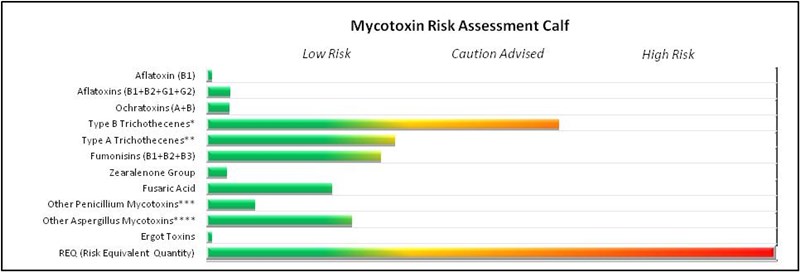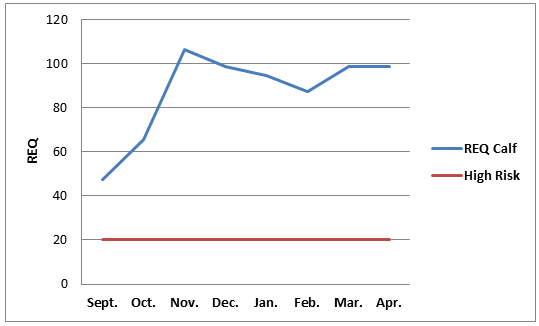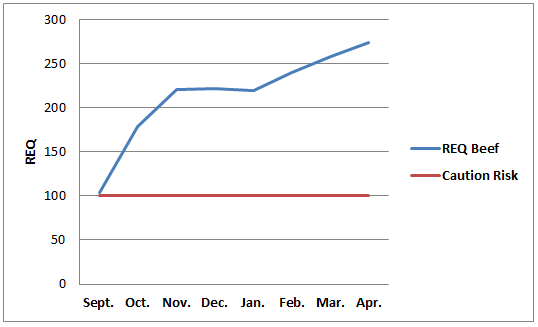Is There a Mycotoxin Risk for Beef Cattle?

How risky is it to feed crops that have mycotoxins to cattle?
By: Max F. Hawkins, Mycotoxin Management Team, Alltech
As we enter the dog days of summer, the remnants of 2013’s stored crop continue to affect calf and feeder health and performance. While it is well-known that ruminants have the ability to breakdown mycotoxins in the rumen, the level of mycotoxins that can be broken down is limited. Also the negative effects of the process are often not taken into account on the ranch or feed yard.
Protozoa in the rumen are the mode of action used to break down mycotoxins. However, certain protozoa only act on certain mycotoxins. When these mycotoxins are altered, they may become more toxic than the original mycotoxin. For some mycotoxins, there are no protozoa available that can break them down and cattle are exposed to the negative effects.
Diet also plays a role. When feedlot cattle are fed higher rates of grain, rumen pH is decreased along with its ability to break down mycotoxins.
While the beef industry is currently experiencing record prices for feeder cattle and fed cattle, feedlot managers must strive to capture all of the performance that is possible, while maintaining feed inputs and reducing health costs.
This spring, Alltech’s North American Harvest Analysis tested 363 samples from across the United States and Canada through their 37+ Lab in order to identify mold and mycotoxin concerns present in total mixed rations (TMRs) and feedstuffs from the 2013 harvest and their expected impact on the health and performance of beef cattle. The analysis considered the mycotoxin challenge present in each sample as a whole rather than just looking at the individual mycotoxins present. In this way, it more closely reflects commercial production and the challenges facing cattle producers around the world.
The 37+ Analysis identifies which of the 38 mycotoxins are present and at what levels. This advanced analytical technique provides a broader picture of the risk. Even when present at low levels, the consumption of multiple mycotoxins can be detrimental to cattle health and performance. For this reason, samples are given a Risk Equivalent Quantity (REQ). This numeric value takes into account the cumulative effect of the mycotoxins present and provides a risk assessment of the threat to health and performance.
Corn silage is a common ingredient and can represent a major portion of cattle diets. Over time, the mycotoxin content of stored feeds often increases due to continuing mold growth. Silage can contain mycotoxins at harvest as well as soil-borne mold spores. These mold spores will produce mycotoxins in storage when the environment provides the correct temperature, moisture or oxygen level. Therefore mycotoxins can and do increase during storage.
Figure 1. Changes in corn silage REQ for calves by month.
Figure 2. Change in corn silage REQ for finishing cattle by month.
The REQ for calves and finishing cattle show a similar trend in that the REQ has increased over time for the 2013 corn silage crop. This could be due to growing season plant stress and damage, the percent of moisture at harvest, poor packing or oxygen exposure. The difference in REQ for calves and finishing cattle as shown in the Figures 1 and 2 (high risk for calves at 20 and caution risk for finishing cattle at 100) is due to calves being more sensitive to mycotoxins. This illustrates the fact that calf health and performance can be at a greater risk due to the number and concentration of mycotoxins present.
Feedlots utilize a wide variety of feed ingredients, and a large portion of them are likely to bring mycotoxins to the TMR. In the same September through April time period, the REQ for calves for ingredients was corn 31.23, high moisture corn 55.85, DDGS 25.38 and haylage 27.65. For finishing cattle corn was 65.59, high moisture corn 157.84, DDGS 70.60 and haylage 52.84. The inclusion rate of these ingredients as well as corn silage will determine the mycotoxin contribution to the TMR. Many times managers and nutritionists will try to control the mycotoxin levels by altering inclusion rates of ingredients high in mycotoxins. This can be a good method, but caution needs to used as many of the substitute ingredients can contribute near equal amounts of mycotoxins.
The risk assessment and REQ for the average TMR during the September through April time period is shown in Figures 3 and 4.
Figure 3. TMR risk assessment for calves

Figure 4. TMR risk assessment for finishing cattle

The risk is greater to calves than finishing cattle as calves are less mature and more sensitive to the mycotoxins. This can also be compounded by the health status and the stress level of the calves during weaning, marketing, shipping and receiving. Although there is no single mycotoxin at high risk, the REQs are at high risk and caution advised categories for calves and finishing cattle respectively. As stated previously, the REQ is a calculation of total risk associated with the group of mycotoxins present.
The risk assessment for calves indicates that dry matter intake may be decreased, growth rate slowed, and gut health and immune response distressed, leading to opportunistic infections with poor treatment response. The REQ for finishing cattle at caution advises that while cattle might not show dramatic effects resulting from mycotoxins, cattle health and performance can be compromised over time. This can result in lost performance and increased health costs.
Some common practices for dealing with a mycotoxin issue in feed:
1. Eliminate the suspected source of the mycotoxin (e.g., silage, haylage, whole cottonseed, almond hulls, etc.)
2. Add mold inhibition products (i.e., use of fungicides or mold inhibitors on the total mixed ration or corn silage)
3. Use mycotoxin sequestering agents in the feed. In many cases, the use of sequestering agent products results in the clinical and/or subclinical symptoms disappearing, and begins the progression of the affected animals or herd returning to normal
Management strategies that prevent exposure to and ingestion of mycotoxins are always the best course of action. When producers suspect mycotoxins present, testing of feed samples should be the first action taken.
The main objective is to continually monitor the stored grain for temperature and moisture, to check for mold growth and analyze for mycotoxin production, prior to feeding the grain to livestock. Be aware of the effects of multiple mycotoxins, implement a mycotoxin control program and be prepared for storage management of the new crop in 2014.









